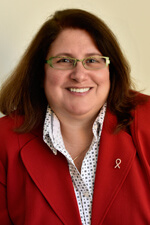Friday, May 12, 2023
New Breast Cancer Screening Guidelines Recommended, But Are They Enough?
By Christine Pellegrino, MD, a breast cancer care specialist at Westchester Medical Center and MidHudson Regional Hospital
 |
| Christine Pellegrino, MD |
The United States Preventive Services Task Force (USPSTF) recently released a draft of updated breast screening recommendations that suggest screening mammograms starting at age 40.
These new recommendations show some definite improvements compared to the last update in 2016 — when the recommendation was to start screening mammograms at age 50 and continue screening every other year after that.
Overall, the change in recommendations from the USPSTF is a clear movement in the right direction. We are seeing increasing numbers of young people diagnosed with breast cancer and data shows that screening starting at age 40 saves about 19 percent more lives.
But organizations like the American Cancer Society (ACS), the American College of Obstetricians and Gynecologists (ACOG), the American College of Radiology (ACR) and the American Society of Breast Surgeons (ASBS) have been recommending annual screenings starting between ages 40-45 for quite some time. While these new USPSTF guidelines are an improvement, the recommendation is still every other year, which I believe falls short of a suitable screening interval.
Younger women have a risk of developing more aggressive cancers, which could go unnoticed during a routine mammogram at first, due to small size (or not being present), and then within the two-year period between imaging, these high-risk tumors can grow and potentially spread.
This can have a direct impact on stage at diagnosis, treatments and outcomes, especially for those with aggressive subtypes, such as triple-negative breast cancer, which are known to grow quickly. Screening every other year increases the risk of missing a tumor.In my 22 years of experience as a breast cancer specialist, I have seen many cases of rapidly growing tumors in young women, that presented within a year after normal mammograms.
The data, along with real world experience, supports annual screening starting at age 40 to most appropriately screen and detect breast cancers at early stages. I believe this is why we see a rise in the number of new cases diagnosed each year, while not seeing an increase in deaths, as more women are diagnosed at earlier stages.
The next step for the USPSTF would be to recommend annual mammograms starting at age 40. This would be in step with other major organizations with guidelines that increase the likelihood of effective screening and early diagnosis.
While the USPSTF states their concern for false positives and unnecessary biopsies as part of the reason for every other year screening, the risk of a missed cancer, an evolving cancer or an upstaged cancer due to a delay in screening are all much more concerning than putting women through the stress of having a biopsy.
Women are willing to accept the stress and anxiety of a false positive followed by a negative biopsy over worrying that something may develop in a two-year period or that they will be diagnosed with an advanced stage once screened. We want to be able to diagnose cancer at the earliest stage possible, and annual screenings give us the best chance for that.
More on this from HealthAlliance Hospital's Ashanda Saint Jean, MD, FACOG
Learn more about the Breast Cancer Program at Westchester Medical Center